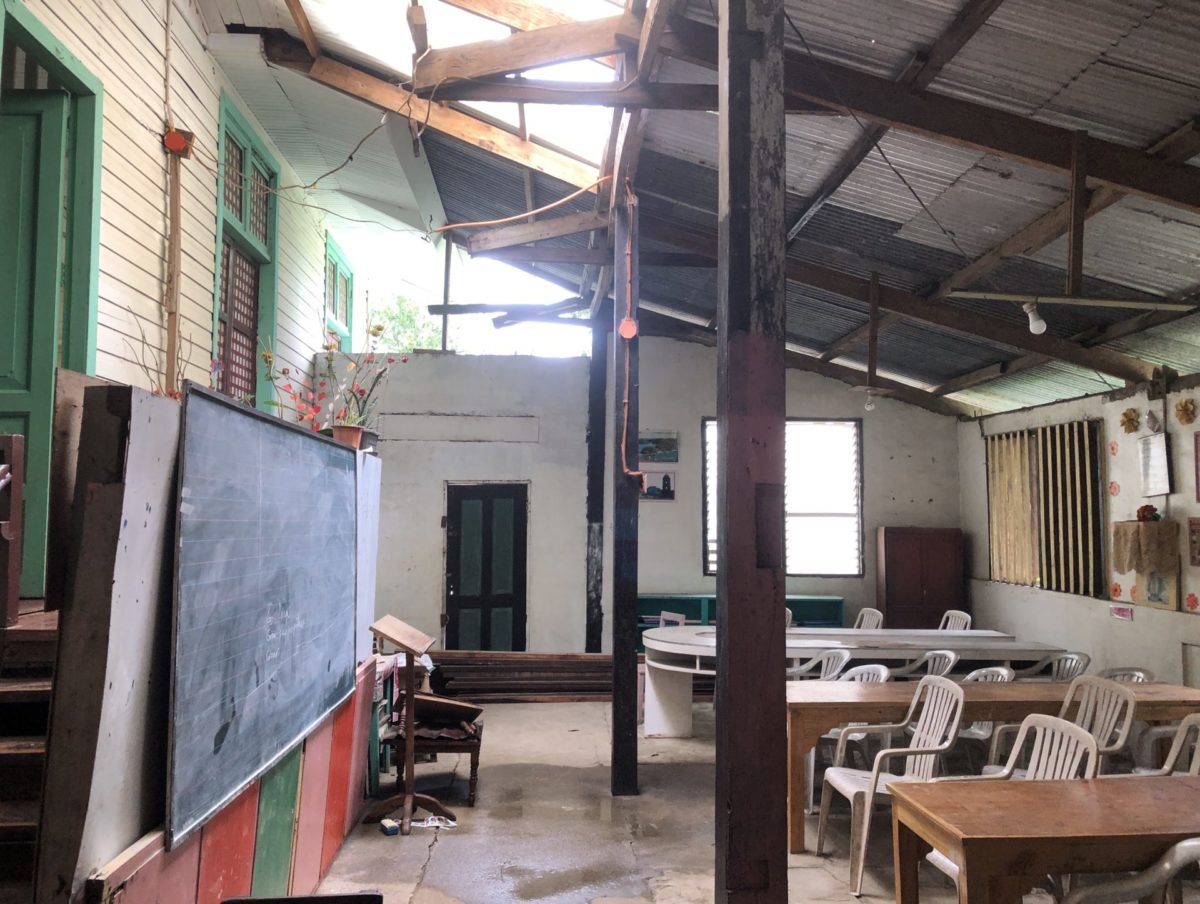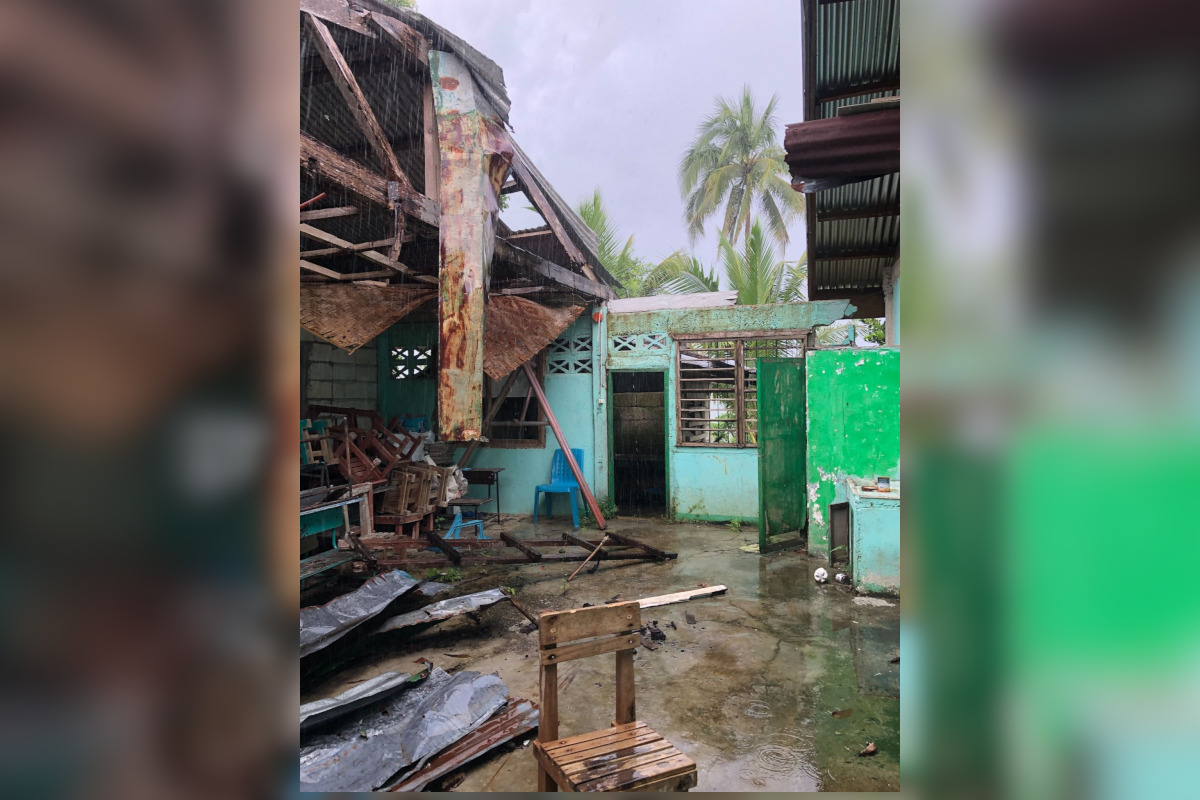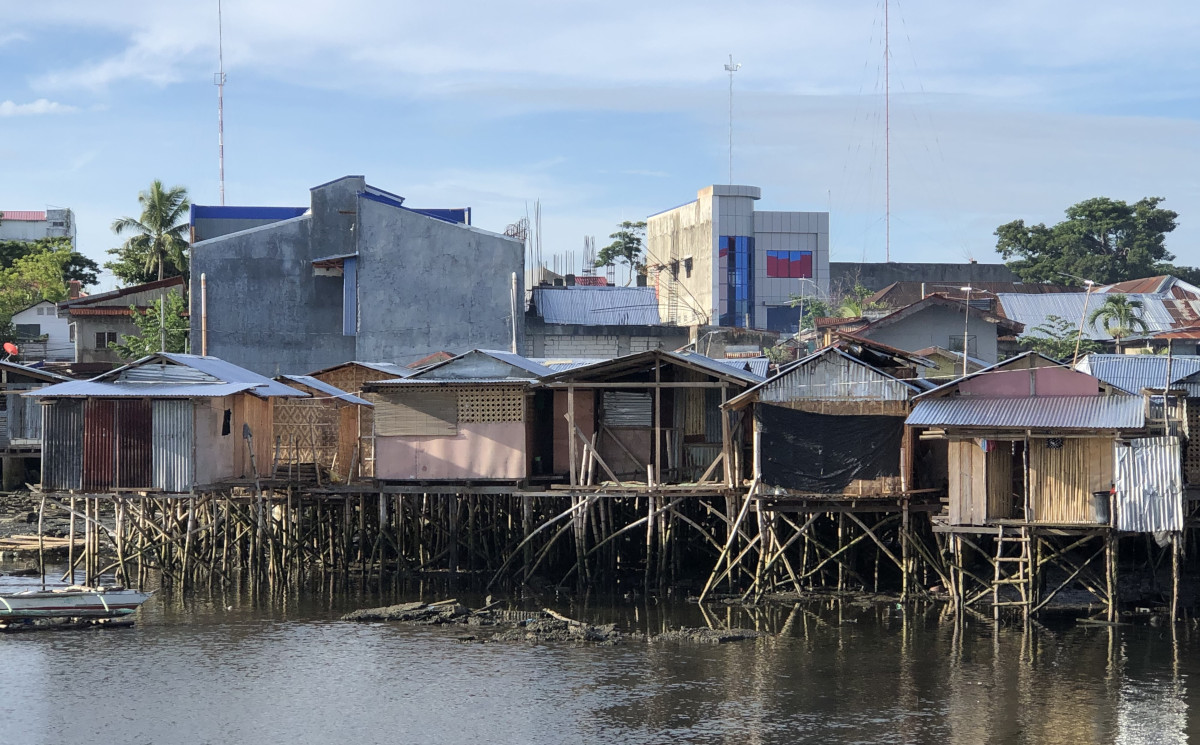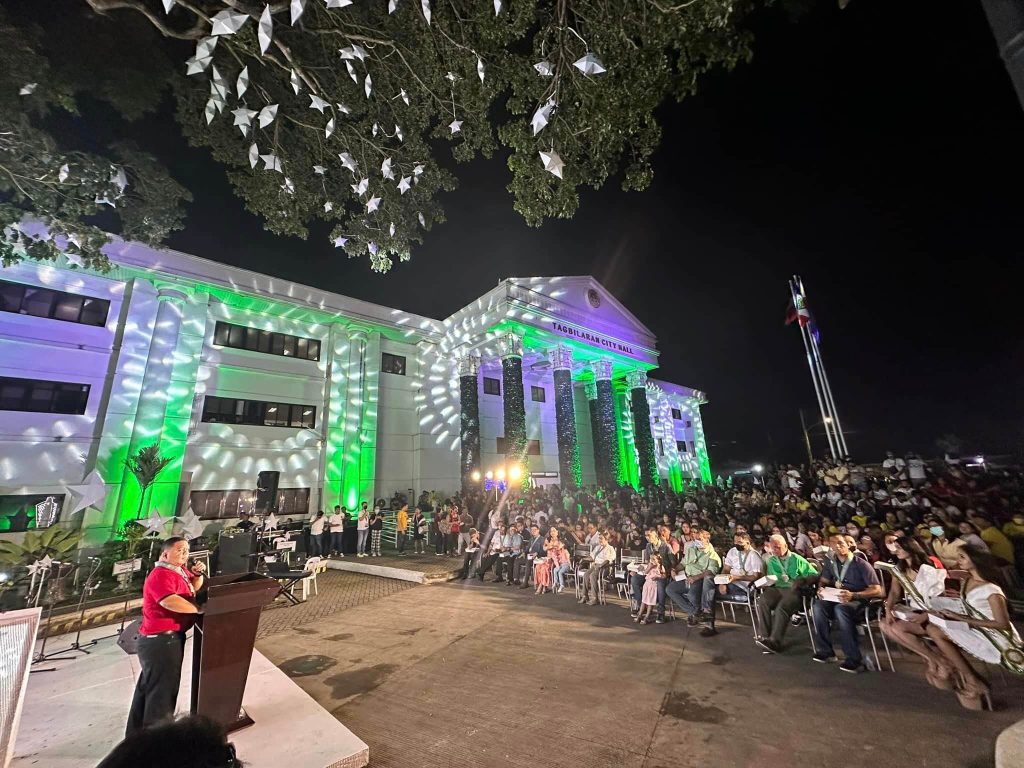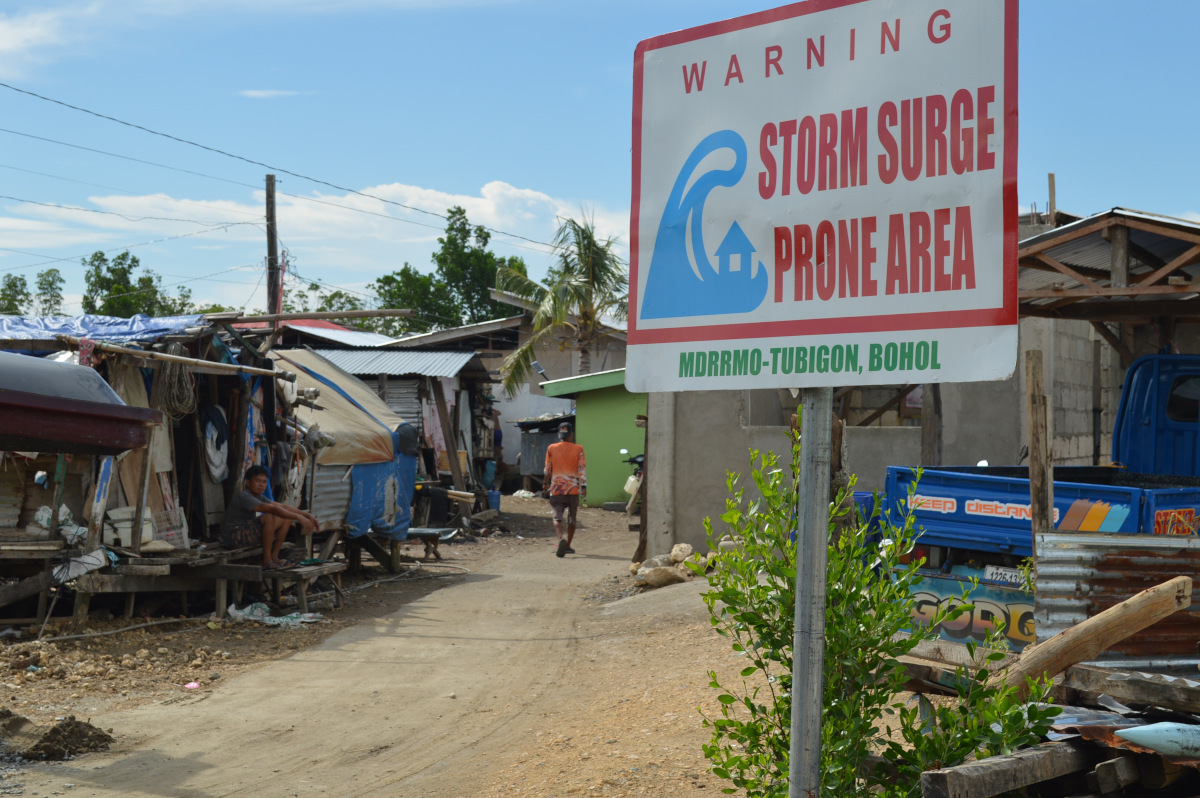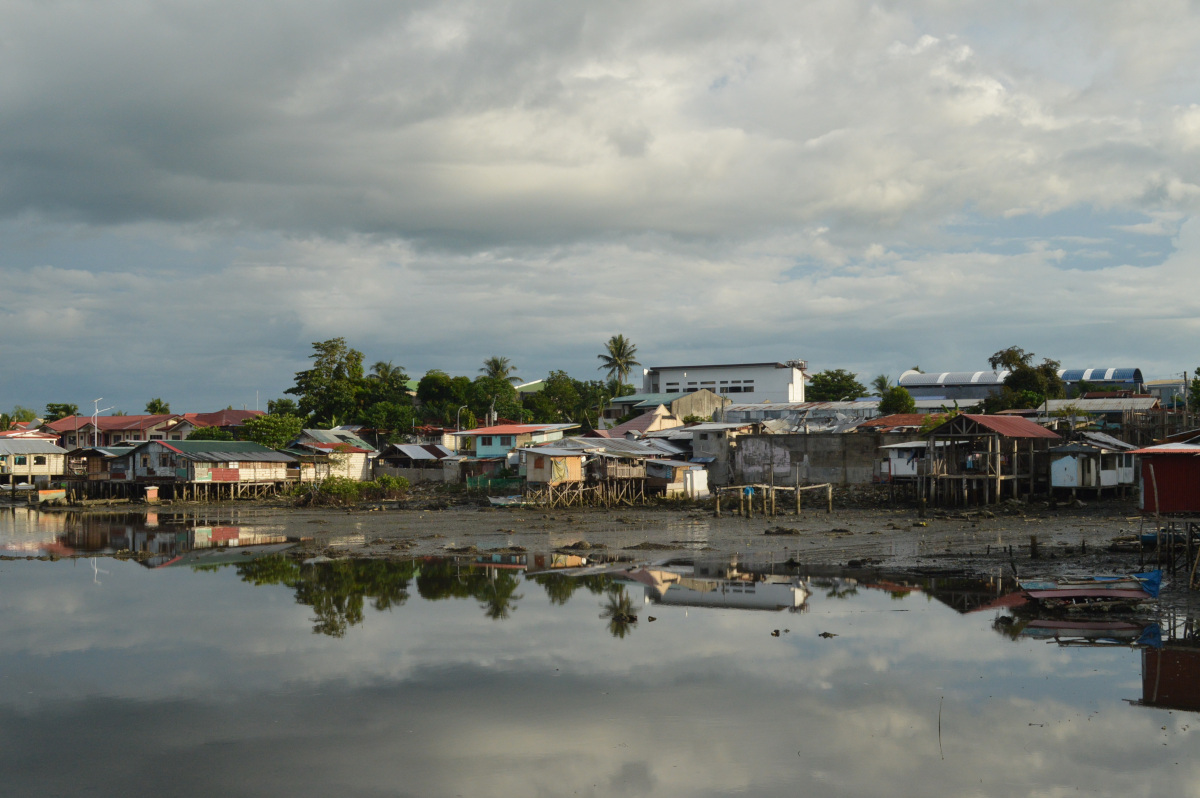Photos by: Ralphfelvin Potane, Ellyza Gamutan, Abegail Inferido and Cooper Resabal
TAGBILARAN CITY – Weeks before the opening of the current academic year last Aug. 29, several schools had to make do with what remained of their learning spaces. Ma. Vita P. Marapao, teacher in charge at Talisay Cabilao Elementary School, had to ask her husband to help repair her classroom.
“The galvanized roofing was yanked open, so water dripped [from] the ceiling, which rotted due to continuous rain. We can’t wait too long for a replacement, so I just asked my husband to repair it, including an aparador (locker). I also hired a carpenter,” she said.
The devastating impact of the storm left teachers facing the daunting task of salvaging learning materials and damaged classrooms that can still be useful.
Traces of Odette’s fury continue to linger on Cabilao Island in Loon town— abandoned buildings, partially repaired houses, and dry-docked barotos (motorboats), making the memory of the typhoon not so distant to the locals. The situation of the schools is no different.
One can hear the banging of hammers as carpenters are still trying to reconstruct or repair some classrooms. A classroom wall remains open, exposing the clutter inside, including a toilet bowl.
On what may have been another classroom before, but now totally exposed, lie little mountain piles of books and paper, that got drenched by rainwater brought by the 240 km/hour howler, but have now hardened.
School children passing by hardly noticed that the crown of a huge balete tree still carries a twisted galvanized iron blown off from a nearby covered court, evidence of the power of the wind that typhoon Odette brought.
Marapao recounted how the strong wind blew off the galvanized iron roofing of the school’s covered court “They looked like clothes being hung out to dry there (on the balete tree nearby).” A team from the local government of Loon helped them, using chainsaws, in clearing the wreckage and debris left by the typhoon.
Initially, the schools used their monthly maintenance and other operating expenses (MOOE) for minor repairs. However, considering that it happened during a period of distant and modular learning, the fund was sorely lacking.
“We had an evaluation meeting in September 2022 and decided to make do with whatever we have. The MOOE was not enough. We ran out of bond paper supply then when we still had the module system,” Marapao recalled. The MOOE is supposed to be used only for school supplies and minor repairs.
Donations from the schools’ alumni helped defray expenses for the things needed in the classrooms such as computer printers.
In Cambaquiz Elementary School, teacher in charge Aimee Leonor Canoy narrated how she took advantage of opportunities for possible help. “By January (2022), then Bohol governor Arthur Yap and his team came, bringing relief assistance. I grabbed the opportunity to talk with them.” She asked for a school building. By March, measurements were taken, and by June 21, 2022, it was completed, Canoy shared.
“When the kindergarten classroom was damaged, we allocated MOOE funds [in] March 2022 to provide a roof and a wall on an old stage,” she said. They have moved from the schools’ dirty kitchen, which they temporarily used to conduct classes until the stage was transformed into a classroom.
Canoy appealed for speedy assistance to recondition at least four classrooms with posts that are damaged by rust and no longer touching the ground, placing the safety of the schoolchildren using it at great risk. Canoy said they’ve drawn from the MOOE P20,000 for the materials for the roof of the stage, P15,000 for the walls and another P15,000 for the water pipe system.
The school has so far not received funding from the national government, but got P100,000 worth of donations from the private sector.
An engineer from DepEd-Bohol told school officials during a visit that the buildings requested for major repairs actually have to be demolished. But due to a shortage in classrooms and other facilities, they decided to repair the visible damages on their own, especially the toilets.
Interior mainland schools’ condition
The poor condition of schools in the province’s mainland is as dire as those on the islands. While accessibility is not much of an issue for mainland schools as it is for island schools, many mainland schools are still waiting for their problems to be addressed.
At the Haguilanan High School in Catigbian, an interior town some 40 km from the capital Tagbilaran, one building, which houses two classrooms, is roofless. The building is bare, with chipped paint and bent, rusty steel trusses. It is a silent scream for help.
“These two rooms needed major repair even before the typhoon. We reported it; that’s where the internet tower was placed. When typhoon Odette came, it yanked the whole roof, and the tower toppled. The rooms used to be the computer lab. Now, we don’t have a computer lab. We lacked rooms, so we used a Tzu-Chi-donated emergency building for holding classes,” narrated Desie Marie Castellano, LIS Coordinator of Haguilanan High School, in an interview.
The building next to it has a big hole on the ceiling and the blackboard was protruding due to the waters that seeped through. The two edifices would pass as candidates for condemnation but because of the classroom shortage it was fixed and used as temporary learning areas.
“Last May when it was awfully hot, we did not want to hold classes there, especially at the center. It was terrible. [It feels] like you are being burned by the heat. We pity the children. Using an extension wire, we used one electric fan. It was really difficult,” Castellano shared.
The Mahayag Norte Elementary School, located in an outlying barangay in Catigbian, is on the same boat. One of its buildings has only half of its roof left—the other half crushed and flung over. Another appears at a glance to be fine, but inside was a picture of agony— with wood trusses beginning to crumble as a result of a nonstop exposure to extreme heat and rain, and its walls are starting to disintegrate as the cliff where the building stands is eroding.
Maricel Tesorio, the school principal, said they had to use the stage as a classroom for Grade 1 students. Talking in Boholano, Tesorio said: “Since the DepEd cannot really fix all school-buildings at the soonest time, we just have to be resourceful in using spaces, even sharing spaces.” Her husband Edjel, the school principal when Odette struck, said they fast-tracked repairs of the classrooms, using whatever funds they could get as the haste to transition from distant and modular learning to face-to-face classes began.
Apart from their monthly MOOE, the schools used donations from the Parent Teacher Association (PTA), Special Education Fund (SEF), and allocations from the local government units, but were still insufficient to repair the damaged classrooms. Tesorio explained the need to balance the use of MOOE for supplies and repairs. “If we do not maintain or repair, the damage would become bigger. If we wait for funding which takes too long, the wood would start to rot, and that’s another damage.”
Every cloud has a silver lining
Forty-two kilometers east of Tagbilaran City lies the coastal town of Valencia. There in Danao Elementary School, three classrooms, including the school’s office, received the typhoon’s wrath, and its roof flung over to other school buildings. “This old classroom was demolished, and the wooden materials swept far away. It was like typhoon Odette brought a steel bar– that yanked out 2×2 wooden materials along with the roof,” said Joselin Idusma, school in-charge.
As a result, learning materials were destroyed. Computer motherboards were damaged by the waters that seeped inside. “That’s it, the storm left computers, everything ruined and useless,” she said.
The classrooms that were severely affected are still left without ceiling. Idusma said construction of the building funded by the LGU Valencia was halted because the P100,000 assistance was already used up mainly for construction materials and workers’ wages. “Out of the P100,000, about 30% is for labor. It is in the program of work,” Idusma said.
While there is still a long way to go, the progress made has helped the teachers and students slowly recover from the devastation.
In addition to Danao Elementary School’s recovery story, another school from Valencia has also shared how they recovered from such calamity. Looking at the affected school now, the typhoon did not seem to have left a mark. The classrooms were clean, furnished and new.
While the banging sounds of hammers were still heard and the smell of paint lingered, the school looked as normal as can be. No signs of destruction and desperation were seen, making everyone think that the news of it being destroyed by Odette was a hoax.
The story of Valencia Central Elementary School’s recovery merits some telling.
A tall mahogany tree directly fell on the building housing three Grade I classrooms. Although the tree directly hit two of the building’s classrooms, the other classroom beside it was also damaged. The aftermath of the disaster was evident in the classrooms’ caved-in roof.
As if the three classrooms’ conditions were not enough, another classroom faced a similar situation. The Grade 4 classroom was built near a massive century-old tamarind (sambag) tree. The size of this tree was quite intimidating, yet it did not stand a chance against Odette’s powerful wind. The once mighty and majestic tree bowed down to Odette, falling directly on the Grade 4 classroom. Just like the others, the roof of this classroom caved in.
“These have been repaired and funded by DepEd. It took some time, and it’s still going on, but some have been repaired a year after,” narrated Mercuria Tagapia, principal of Valencia Central Elementary School.
With what was left, the teachers had no choice but to utilize other areas as temporary learning spaces for the four classes. The Home Economics (HE) Room, Audio Visual (AV) Hall, the Edukasyong Pantahan at Pangkabuhayan (EPP) classroom, and the small School Canteen are among the areas that the students temporarily used while waiting for their classrooms to be fully repaired.
But the waiting game took a long time, and the students used the four areas for over a year.
Although the DepEd provided funds through MOOE, more was needed to repair the heavily damaged areas. It is, however, used to repair the minor damages to the school, according to Tagapia. “We did not use the MOOE for major repairs because that is for minor repairs. If you depend on the MOOE, even if you pour it all there, it will never be completed,” she said.
For over a year, the teachers and students patiently waited for the funds to arrive, understanding that other schools needed more immediate help than them. When DepEd gave the school around P600,000, they were able to repair the damaged classrooms, Tagapia said.
A lot still needs to be done
When asked if there had been a significant recovery in the repair or reconstruction of damaged schools in Bohol after Odette, Bautista said there is still a lot to be done since minimal funds have been released, mainly for repairs.
“In terms of repair you’re only given P20, 000. What is P20, 000? How many [pieces of] plywood is [worth] P20, 000? That’s minus the labor, which is P500 per day?” she pointed out.
Many schools still operate in makeshift classrooms that are cramped and unsafe for students. These schools still need to find ways to replace damaged books and computers, and repair or reconstruct buildings and classrooms to provide a safe learning environment for students.
There are also stories of success, like the story of the Valencia schools that have risen after being damaged by fallen trees, which serve as reminders that even in the face of disaster, it is possible to rebuild and recover.
Most schools are still recovering from the devastation. Yet, there are some that have defeated the odds, returning to what they once were as if the destruction never existed. While recovery seemed like a distant dream, sacrifice, patience, coordination and partnerships had helped them succeed.
(The story was produced by staff writers and adviser of The Word, the campus paper of Holy Name University, with the guidance of correspondent Cooper Resabal, who participated in a workshop on Post-Disaster Accountability Journalism, a project of VERA Files and the International Media Support, in partnership with the Center for Community Journalism and Development).
